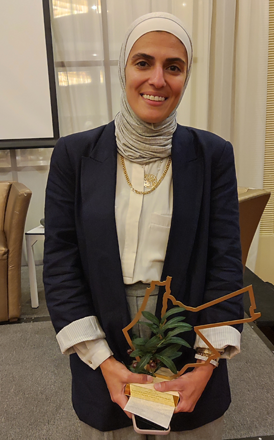Making history by being the first Jordanian and Arab female doctor to enter Gaza, Asil Jallad assisted in delivering 500 babies during her two-month voluntary work in the war-torn Strip.
Jallad, an obstetrics and gynecology specialist, has volunteered with the International Medical Corps and arrived to Gaza during the sixth week of the Israeli offensive on October 7.
With a daily workload of 10 to 15 childbirths, Jallad said she was extending medical assistance to Gaza’s most marginalised populations: Women and children.
Citing a UN report, Jallad said that every 10 minutes, a child is born in Gaza. Currently, between 50,000 to 60,000 women are pregnant, and there are approximately 155,000 women, including pregnant women and wet nurses, in need of medical attention.
Reflecting on her experiences, Jallad hailed the resilience of the women of Gaza, whom she described as the “true heroes amidst the chaos of war”.
“When I decided to go to Gaza, they kept telling me that I am a hero, but when you see the women of Gaza, you realise that you are merely a small heroine compared to the heroes you see every day,” she said.
In her role at the field hospital in the southern region by the International Medical Corps, Jallad said she had focused on providing comprehensive care for pregnant women, conducting surgeries, and offering consultations on sexual and reproductive health.
Despite grappling with limited medical equipment and resources, the International Medical Corps clinics in the field hospital in Gaza provide medical aid to 700 to 1000 patients every day, with the female clinic alone attending to 100 to 120 patients daily.
Jallad has witnessed firsthand the dire consequences of malnutrition among women in Gaza, leading to blood deficiency, dehydration and reproductive health issues.
She emphasised the “profound” challenges faced by pregnant women, including the dire shortage of postnatal care facilities. “Due to the limited number of beds available, pregnant women are compelled to vacate the center within two hours of giving birth, depriving them of crucial recovery time and support.”
“Pregnant women should have 10.5 hemoglobin levels as minimum, however I saw a pale pregnant woman with 4 hemoglobin level walking on her feet to support her other children in the tent.”
“One of the most touching cases, is when people come to consult to get pregnant, because the six months of war means six months in a woman’s life, and age is considered the most important factor in the pregnancy and birth.”
According to UNFPA, around 155,000 pregnant women and new mothers in Gaza are in desperate need of basic healthcare, while 690,000 women and girls in Gaza lack access to menstrual hygiene supplies and privacy with some reports of contraceptive pills being taken to avoid the unhygienic menstrual conditions.
Jallad said that the dire living conditions of displaced Palestinians, cramped into tiny tents with inadequate facilities, exacerbate the humanitarian crisis.
She decried the scarcity of essential medical supplies and the impact of restrictions on medication entry imposed by Israeli authorities.
As the conflict continues, Jallad warns of the looming threat of chronic health problems and blood clots due to the lack of medical aid delivery to the strip. She stresses the urgent need for increased access to medical care, particularly for pregnant women and new mothers who are struggling to survive amidst the devastation.
“Deformities will be seen in the next few years, or in the next 10-20 years, as we don’t know what are the ingredients used in the bombs.”
Jallad shed light on the mental health toll of the conflict, with many individuals unaware of the whereabouts or well-being of their families.
Despite recent efforts to improve medical facilities in certain areas, Jallad raised concerns about the neglect of the north, where millions of refugees reside. She underlined the urgent need for sustained international support to address the ongoing medical and humanitarian needs across Gaza.
Seven months since Israeli strikes began in response to October 7 attack, more than 10,000 women have been reportedly killed in Gaza, among them 6,000 mothers. Some 19,000 children have been orphaned, UN Women said.
The UN agency’s survey of 360 respondents, including 182 women in Rafah, revealed disturbing data that more than six in 10 pregnant women reported complications, including 95 per cent with urinary tract infections and 80 per cent with anemia. In households with nursing mothers, 72 per cent reported challenges in breastfeeding and in meeting the nutritional needs of their babies.
source/content: jordantimes.com (headline edited)
_________

___________
JORDAN


